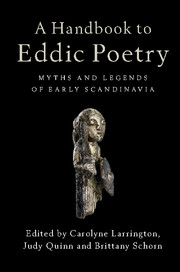Book contents
- Frontmatter
- Contents
- List of illustrations
- List of contributors
- Translations and abbreviations of the titles of eddic poems
- Introduction
- 1 The transmission and preservation of eddic poetry
- 2 Traditions of eddic scholarship
- 3 The editing of eddic poetry
- 4 The dating of eddic poetry
- 5 Eddic performance and eddic audiences
- 6 Eddic poetry and mythology
- 7 Eddic poetry and the religion of pre-Christian Scandinavia
- 8 Eddic poetry and heroic legend
- 9 Place names in eddic poetry
- 10 Eddic poetry and the imagery of stone monuments
- 11 Eddic poetry and archaeology
- 12 Eddic modes and genres
- 13 Eddic metres
- 14 Eddic style
- 15 Kennings and other forms of figurative language in eddic poetry
- 16 Alliterative lexical collocations in eddic poetry
- 17 The representation of gender in eddic poetry
- 18 The reception of eddic poetry
- Consolidated bibliography
- Index
18 - The reception of eddic poetry
Published online by Cambridge University Press: 05 August 2016
- Frontmatter
- Contents
- List of illustrations
- List of contributors
- Translations and abbreviations of the titles of eddic poems
- Introduction
- 1 The transmission and preservation of eddic poetry
- 2 Traditions of eddic scholarship
- 3 The editing of eddic poetry
- 4 The dating of eddic poetry
- 5 Eddic performance and eddic audiences
- 6 Eddic poetry and mythology
- 7 Eddic poetry and the religion of pre-Christian Scandinavia
- 8 Eddic poetry and heroic legend
- 9 Place names in eddic poetry
- 10 Eddic poetry and the imagery of stone monuments
- 11 Eddic poetry and archaeology
- 12 Eddic modes and genres
- 13 Eddic metres
- 14 Eddic style
- 15 Kennings and other forms of figurative language in eddic poetry
- 16 Alliterative lexical collocations in eddic poetry
- 17 The representation of gender in eddic poetry
- 18 The reception of eddic poetry
- Consolidated bibliography
- Index
Summary
Introduction
Eddic poetry has been far and away the most influential genre of Old Norse literature. Its reception – not only in Western Europe and North America, but throughout the world – has been wide-ranging, far-reaching, and long-lasting. Although its influence has been most evident in literary texts, there are representations of eddic scenes in the visual arts – from Viking Age sculpture to Western European romantic art and beyond. In spite of rather little evidence for musical performance in Old Norse, eddic poetry has also inspired music of various kinds – most notably, of course, Richard Wagner's Ring Cycle. As a vehicle for Old Norse mythology, and the supposed vessel of ancient Germanic religious beliefs, its influence on the history of ideas, and especially on political thought, has been particularly significant, and the subject matter and ethos of eddic poetry have continued to make their mark on popular contemporary culture.
I shall use the term ‘reception’ to refer to three processes: the post-medieval dissemination of the texts themselves, direct critical response to them, and evidence of their influence on later works. I will discuss the influence of eddic poetry on literature (primarily in English) in three sections: the influence of the verses in fornaldarsögur (sagas of ancient times) (especially the sequence of verses known as The Waking of Angantýr), the influence of mythological verse, and the influence of the heroic poems about Sigurðr and Brynhildr. Along the way, I will consider the influence of eddic poetry on visual art and on music, and then on the history of ideas; I conclude with a brief account of its reception in popular contemporary culture. I will be as inclusive as possible about which poems may be designated ‘eddic’. As we shall see, some of the most widely and popularly received eddic poetry is found outside the Codex Regius.
Before examining the post-medieval dissemination of eddic poetry, we should briefly consider its oral prehistory. Its existence is evident from Viking Age sculpture, such as representations of Sigurðr the Dragon-Slayer, many of them from Britain, and a number of Viking Age sculptures seem to represent scenes from ragnarǫk as alluded to in Vǫluspá.
- Type
- Chapter
- Information
- A Handbook to Eddic PoetryMyths and Legends of Early Scandinavia, pp. 349 - 365Publisher: Cambridge University PressPrint publication year: 2016

